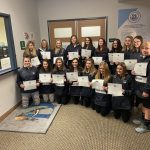High school sports are on the way back in Pennsylvania, but under strict guidelines.
As expected, Gov. Tom Wolf gave the go-ahead Wednesday by releasing extensive guidance that focuses on social distancing, maintaining sanitized facilities, limits on sizes of groups and the amount of physical contact among athletes and coaches.
Teams can return to organized activities as long as they are “in alignment with the PDE Preliminary Guidance for Phased Reopening of Pre-K to 12 Schools and the CDC Considerations for Youth Sports,” according to a new release from the governor’s office. High school sports have been shut down since March 13 due to the coronavirus pandemic.
While the decision to return to sports will be at the discretion of individual schools, a school entity must adopt an athletics health and safety plan approved by the governing body of that school that meets the state’s guidelines prior to conducting sports-related activities with students.
“Pennsylvania has some of the best athletes and teams in the country and they can now begin to safely return to organized sports,” Wolf said in the news release. “This guidance balances keeping student athletes safe from COVID-19 while allowing them to participate in an important part of their lives.”
The directive opens the door for the Pennsylvania Interscholastic Athletic Association to allow sports to resume in counties in the yellow or green phase of the reopening plan. Schuylkill, Berks, Dauphin, Lebanon and Luzerne counties are all in yellow, with Carbon, Columbia and Northumberland already in green.
Last month, the PIAA Board of Directors granted executive director Dr. Robert Lombardi the ability to give programs the go-ahead to start workouts ahead of July 1, and now with these guidelines, he feels the schools can establish when their teams can start.
“Looking at it, the way I am reading it, if a school has developed a plan and it is approved by the board and posted on the school’s website, voluntary workouts can commence,” Lombardi said. “That’s why we had that release last week to give school’s a head’s up that they were going to need to have protocols ready.”
Also, any sports-related activities in yellow or green phased counties must adhere to the state’s gathering limitations, which is 25 people in yellow and 250 people in green.
Official practices for fall sports, which include football, girls volleyball, girls tennis, boys and girls cross country, boys and girls soccer, boys and girls golf and water polo, begin Aug. 17. Heat acclimatization starts Aug. 10.
“I know we are going to have another conversation with the Department of Education on the next step,” Lombardi said. “What I can say is, I think this is a step that helps schools open up their campuses for conditioning and voluntary workouts as soon they formulate the safety protocol and get it approved. Plus, it addresses all counties in the state, because everybody is in either yellow or green, so that is a good aspect of this action.”
Some of the highlights pertaining to school sports activities:
- Coaches and league officials must review and consider the CDC guidance on consideration for youth sports to modify practices and games to mitigate the risk of spreading the virus. This includes focusing on individual skill building versus competition and limiting contact in close contact sports.
- The community, league, or team must designate a primary point of contact for all questions related to COVID-19, and all parents, athletes, officials, and coaches must be provided the person’s contact information.
- The community, league, or team must develop a plan of action in the event an athlete, coach, or official falls ill, make the plan publicly available, and explain it to the entire sport community.
- The community, league, or team must educate all athletes, staff and families about the symptoms of COVID-19 and when to stay home. Athletes also should be educated on proper hand washing and sanitizing.
- Coaching staff and other adult personnel should wear face coverings (masks or face shields) at all times, unless doing so jeopardizes their health.
- Coaches and athletes must maintain appropriate social distancing at all times possible, including in the field of play, locker rooms, sidelines, dugouts, benches, and workout areas. During down time, athletes and coaches should not congregate.
- Coaches and athletic staff must screen and monitor athletes for symptoms prior to and during games and practices. If individuals participating in sporting activities show symptoms, have a temperature of 100.4 degrees or higher, or are sick, they must be sent home.
- All athletes, coaches, and officials must bring their own water and drinks to team activities. Team water coolers for sharing through disposable cups are not allowed. Fixed water fountains should not be used.
- Activities that increase the risk of exposure to saliva must not be allowed including chewing gum, spitting, licking fingers, and eating sunflower seeds.
- Avoid shaking hands, fist bumps, or high fives before, during or after games and practices. Limit unnecessary physical contact with teammates, other athletes, coaches, officials, and spectators.
- Whenever possible, equipment and other personal items should be separated and not shared. If equipment must be shared, all equipment should be properly disinfected between users.
Joby Fawcett has covered high school sports — including football, girls and boys volleyball, girls and boys tennis, girls and boys swimming, boys basketball, girls and boys track and field, and girls and boys lacrosse — for 22 years. The High School Sports Blog offers deeper insights plus statistical and historical information for fans and features photos, videos and graphics along with Top 5 polls for tennis and volleyball. Contact: jbfawcett@timesshamrock.com; 570-348-9100 x5367; @sportsTT


